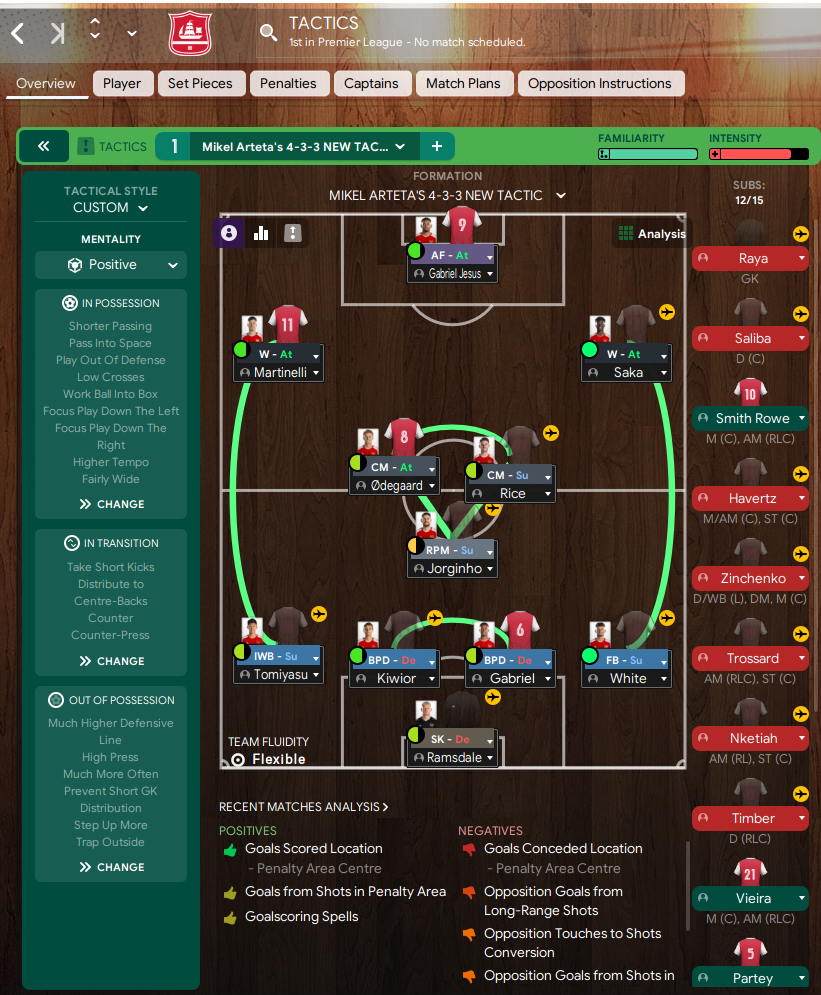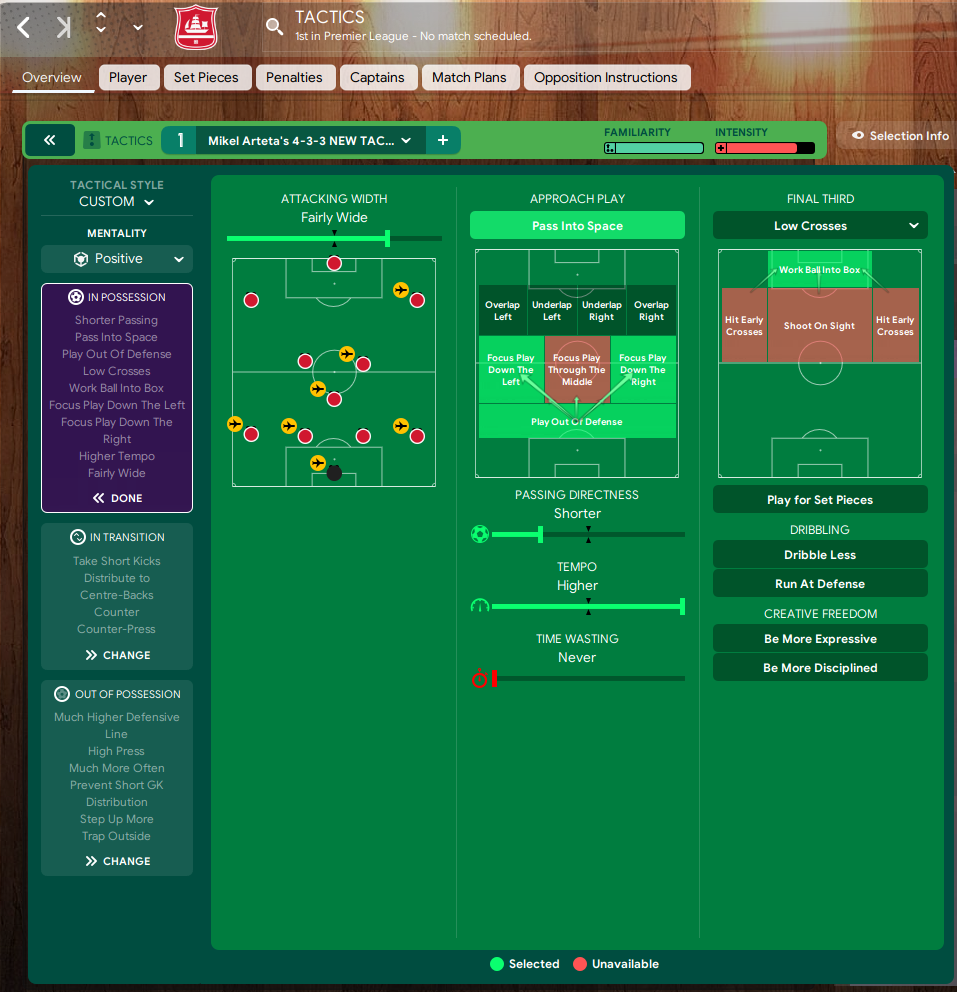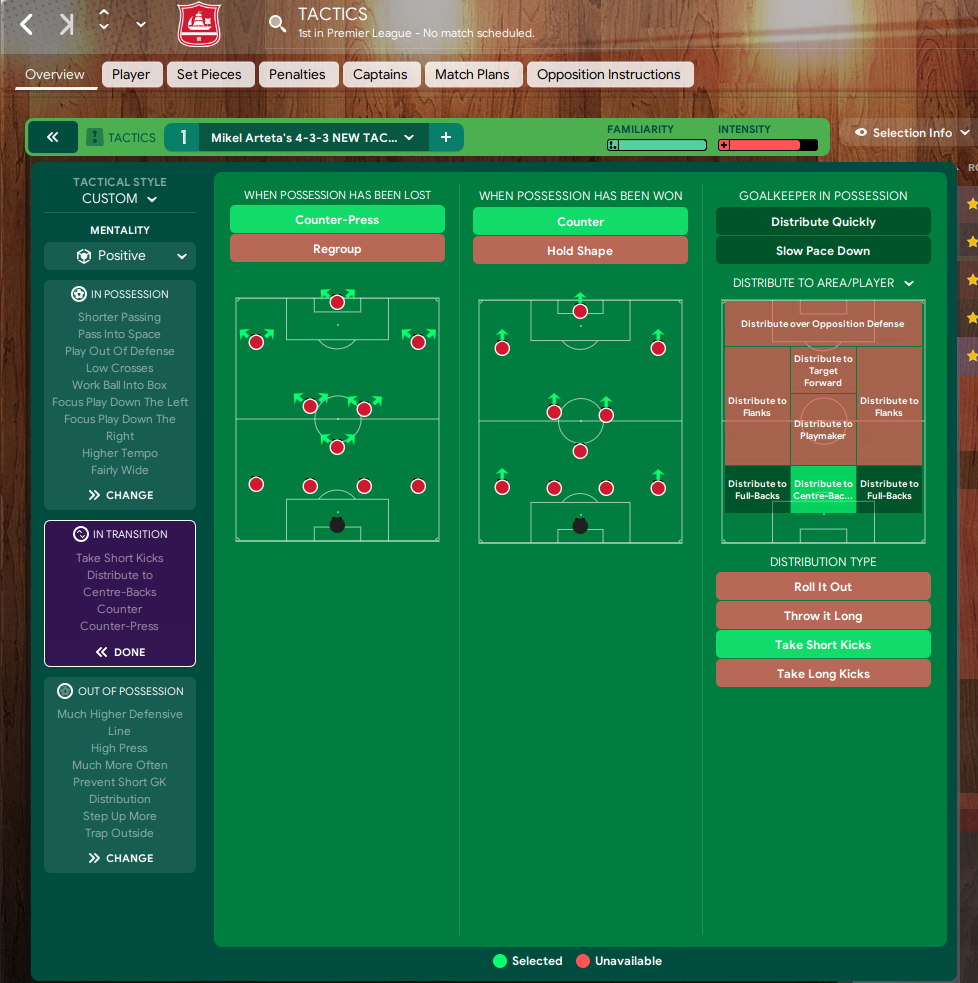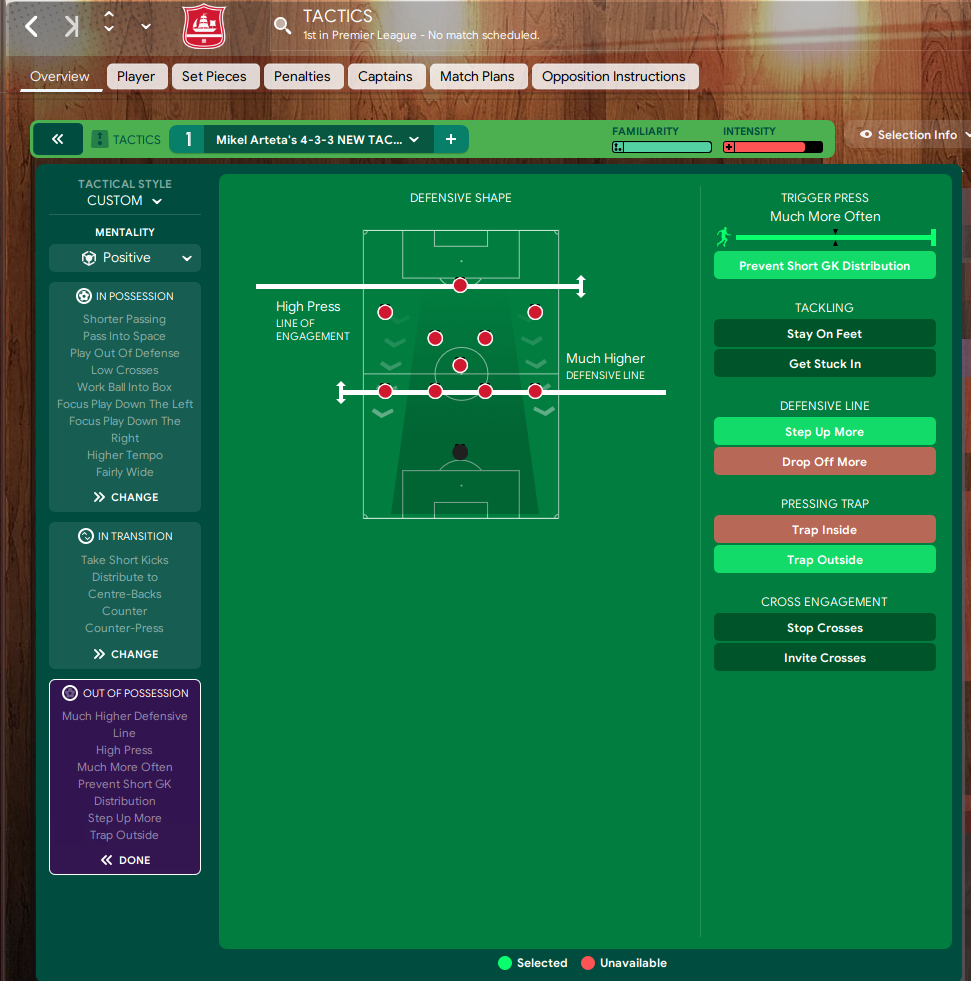| Tester | Team | ME | Win % | PPG | AGF | AGA | GD | PL | W | D | L | |
|---|---|---|---|---|---|---|---|---|---|---|---|---|
| Deleted User #1866315 |
 Arsenal
Arsenal
|
24.3 | 89% | 2.79 | 3.1 | 0.6 | 2.47 | 38 | 34 | 4 | 0 |
ARSENAL 2023-2024 TACTIC IN FOOTBALL MANAGER 2024
Hi guys, this time I created Mikel Arteta's tactic. Actually, in my FM 23 playlist, last year, I already created Arteta's tactics of this 2023-2024 season (3 versions plus a 4-2-3-1 he used in the 2021-22 season) but this time I decided to create Arteta's most recent tactic, a 4-3-3 (that can become a 4-2-3-1 if Odgaard from the CM position switches to an AM).
TACTICAL ANALYSIS
Within the realm of football tactics, Mikel Arteta emerges as a mastermind, guiding Arsenal through a nuanced dance of strategy and execution. This thorough examination unveils the intricate layers of Arteta's managerial style, from orchestrating build-up play to fortifying defense and igniting attacking prowess.
At the start of the season, Arsenal's tactical setup retained elements from their previous campaign, notably the steadfast 3-4-3 formation, with fullbacks playing key roles. However, they faced a significant challenge in their narrow buildup approach, which hindered their ability to penetrate through the heart of the pitch. With only a quarter of their play directed through the middle, it became evident that their midfield dominance was ineffective unless they could transition the ball effectively.
Opposing teams, recognizing this vulnerability, intensified their pressure, particularly targeting Zenchenko and Rice. While Zenchenko tried to thread passes through the lines, he often found himself isolated or pressured into recycling possession. Rice, though competent, lacked the incisive passing threat to break through defensive lines, prompting teams to give him more space, confident in his preference for possession retention over penetrating passes.
Consequently, Arsenal's attacking prowess was stifled, with the central trio struggling to receive the ball in dangerous areas. While they could still exploit wide areas, particularly the right flank with the influential O'Dard, this was often a reactive strategy dictated by the opposition's defensive setup.
Arteta, always the tactician, swiftly devised a solution. By involving the goalkeeper more in the buildup, Arsenal gained an additional passing option, freeing up a fullback to venture forward or widen the play. This adjustment proved particularly effective against teams hesitant to press, allowing Arsenal to dictate play with prolonged passing sequences.
Furthermore, Arteta capitalized on the surplus man in defense, deploying variations of a 2-3-5 formation to assert dominance in possession. Against lesser sides, they took control, with fullbacks joining the midfield pivot to create passing angles and overload the midfield. This structural fluidity empowered Arsenal's attacking quintet, offering multiple avenues to breach opposition defenses.
A pivotal development arose from Zenchenko's injury, prompting Arteta to recalibrate his approach. With Kio deputizing at left-back, Arteta orchestrated a midfield reshuffle, integrating Jinho and K Vertz to enhance vertical movement and offensive threat. This tactical adjustment revitalized Arsenal's attacking play, granting them newfound flexibility and unpredictability.
In essence, Arteta's Arsenal epitomizes adaptive brilliance, seamlessly transitioning between tactical frameworks to exploit opponent weaknesses. As they continue their pursuit of multiple trophies, one thing is certain: this season could mark the dawn of a legendary era for Arsenal Football Club.
Build-up Approach:
In the initial build-up phase, Arteta employs a bold 1-4-2-4 setup, compelling opposition defenders into tough choices. The presence of two high strikers creates space for midfield penetration and isolates wingers for potential one-on-one duels. Moreover, the use of inverted fullbacks bolsters midfield control, facilitating precise possession through central channels.
Transitioning to the high build-up, Arsenal adopts a 1-3-2-2-3 formation, prioritizing numerical superiority in midfield. A high defensive line aids in counter-pressing, disrupting opponent possession and triggering quick turnovers.
Attacking Strategies:
Arsenal's effectiveness in the final third is evident in their exploitation of half-spaces and coordinated overlapping runs. Winger movement, featuring inverted positioning, generates space and opportunities for decisive attacking moves. The integration of attacking midfielders into the box creates numerical advantages, complicating defensive setups and enhancing scoring chances.
Creative Initiatives:
Arteta's approach revolves around creating space for playmakers like Havertz and Odegaard. Their strategic positioning capitalizes on midfield dominance, enabling precise passes that pierce through defensive lines. Implementing the third-man principle further amplifies creative playmaking, facilitating intricate ball movement and bypassing defensive barriers.
Set-Piece Tactics:
Arsenal's set-piece routines emphasize unpredictability and variation, often resulting in goal-scoring opportunities. Particularly, their corner setups exploit aerial prowess, with clever movements posing challenges for defenders and maximizing scoring potential.
Defensive Structure:
Arteta instills a proactive defensive mindset, marked by high pressure and compactness. Arsenal's aggressive press disrupts opposition build-up, leading to turnovers in advantageous positions. Conversely, in a deeper defensive stance, the team maintains a structured mid-block, gradually pushing up to limit opponent space and opportunities.
Transition Management:
Both defensive and offensive transitions are crucial components of Arteta's tactical framework. Arsenal excels in defensive transitions due to central positioning and numerical advantages, swiftly regaining possession after turnovers. Offensively, they capitalize on counterattacks with speed and precision, exploiting defensive gaps to create scoring chances.
HOW I CREATED THIS TACTIC IN FOOTBALL MANAGER 2024
This tactic allowed me to win all trophies and score a lot of goals without conceding too much at least in Premier League, while in UEFA Champions League I had an incredible match against PSG won 6-4, that was scary because even if I won in the first leg home, in Paris since the match started PSG dominated my Arsenal and I thought I was going to lose, but the Gunners spirit fought back and we were able to win again.
Sometimes I struggled to score against weaker teams who park the bus in front of their box, well, with those teams you can switch the mentality to attacking and even remove the "work the ball into the box" instruction so that your players will not be forced to continue to pass the ball back and forth. In fact, both the "play out of defense" and "work the ball into the box" are important for a possession-based tactic like Guardiola's tikitaka, Xabi Alonso's Bayer Leverkusen (Xabi Alonso played for Bayern during the Guardiola era so he learnt a lot from Pep and also from Mourinho and Ancelotti) but in the game highlights we will see our players passing the ball back many times when they are in the midfield and also when they are near the opponent's box, that is not what we see in Arsenal's games or even in Xabi Alonso's Bayer Leverkusen games (just watch last week Europa League game AS Roma vs Bayer Leverkusen to understand what I am saying).
I leave these two instructions in my tactic and you can use it when you start the game, but if you struggle to score, please feel free to remove them.
I hope this tactic works for you too
Thanks everyone
Test Results
 Arsenal
Arsenal
You'll need to Login to comment




